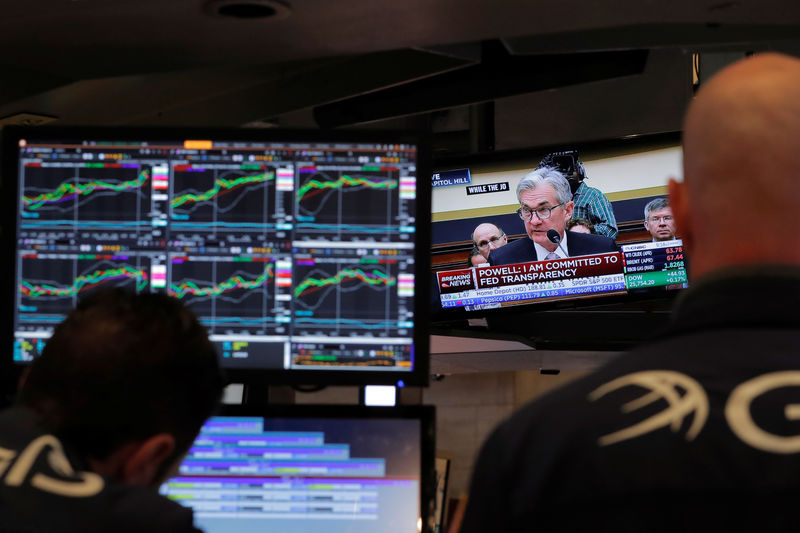 © Reuters. Federal Reserve Chairman Jerome Powell speaks on a television as traders work on the floor of the New York Stock Exchange in New York
© Reuters. Federal Reserve Chairman Jerome Powell speaks on a television as traders work on the floor of the New York Stock Exchange in New YorkBy Howard Schneider and Jonathan Spicer
WASHINGTON (Reuters) – U.S. Federal Reserve officials convinced the massive U.S. bond market has fundamentally changed in the last decade are about to test their commitment to that idea against investors who have begun betting against the U.S. central bank’s ability to continue raising interest rates.
In what could set the stage for a volatile 2019 if the Fed acts more aggressively than investors expect, top policymakers are maintaining their view that nosediving bond spreads don’t give the same sour signal about the economy that they used to.
Investors typically demand higher yields to commit money for longer periods of time. When short-term rates rise above long-term rates and “invert” the yield curve, it has been a reliable predictor of recession, though sometimes several months later, as confidence in the economic future erodes.
Instead of just reflecting investors losing faith, Fed officials have argued that the recently narrowing gap between short- and long-term Treasury bonds could reflect long-term shifts in global capital flows, or the fact that all interest rates are lower and more compressed together than they used to be. The central bank’s own large balance sheet may even be a culprit, by helping hold down long-term rates.
Other forces may be at work that would not necessarily change the Fed’s underlying plans, such as a recent drop in oil prices that could hold down the interest demanded by investors by lowering expected inflation.
The closely watched spread between two-year and 10-year bonds dipped below 0.1 percentage point on Tuesday, the lowest since before the last recession and continuing a slide that began in October.
U.S. stocks slumped nearly three percent on Tuesday on some of the same growth concerns influencing bond investors as well as on doubts China and the United States would resolve their trade spat.
Far from the U.S. facing trouble, however, New York Fed President John Williams (NYSE:) said on Tuesday the economy is strong and the base case outlook is for rate increases to continue through 2019.
“I do continue to expect that further gradual increases in interest rates will best foster a sustained economic expansion,” Williams said at the New York Fed.
“Sometimes there will be market reactions or interpretations of things that move around. But I think I’m focused on our goals and getting the policy right,” Williams said.
That has been a common view at the Fed, including among top officials like Chairman Jerome Powell. Asked about the possibility of an inversion at a June press conference, Powell said “what we really care about is what’s the appropriate stance of policy.”
Given the current functioning of the world economy, “arguments are made that a flatter yield curve has less of a signal embedded in it” about coming economic performance.
PUT TO THE TEST
The theory may get a test soon. As the spread between two- year and 10-year securities neared zero, the gaps between some other yields, including the two year and three year, were already upside down. A separate spread between 3-month and 10-year Treasury securities, considered by some as a better recession predictor, was also falling, though at just around 0.5 percentage point it remained comfortably in positive territory.
“Investors are coming around to our downbeat view of the prospects for the U.S. economy,” analysts at Capital Economics wrote on Tuesday, arguing that there was no reason to regard this pending yield curve inversion as different from others.
Regardless of other possible reasons, “it is mainly indicative of worries about how long growth in the U.S. can remain so strong.”
The state of the yield curve has been a topic of Fed discussion for much of this year, as the central bank raised short-term rates roughly once a quarter, but longer-term bond yields failed to keep pace.
While some regional bank presidents have been explicit in arguing the Fed should hold off raising rates to avoid an inversion, the consensus has been consistent: stay the course.
Williams, a permanent voter on policy and considered among the top economists at the central bank, said in September an inversion would not be “worrisome” or a “deciding factor” in setting policy.
That message, of a Fed committed to a strategy that would not be shaped by short-term data, was echoed this week by Fed vice chair Randal Quarles. Powell in remarks last week reiterated his upbeat outlook of an economy growing above potential, with the unemployment rate the lowest in nearly 50 years, and in no need of emergency level interest rates.
But markets are doubtful. In recent weeks expectations about what the Fed will do next year have eroded, with investors now anticipating policymakers will raise rates only one time next year, and, coupled with an expected increase in December, pause with a federal funds rate of around 2.7 percent.
The Fed, as of September, expected to hit 3.1 percent by the end of 2019 and continue as high as 3.4 percent the following year. Fresh projections will be issued when the Fed meets on Dec. 18 and 19.
“The curve has to invert and it’s going to happen sooner than people think. If twos and 10s invert between now and Dec. 18, the Fed is going to have to take out some of the hikes next year, or they should do it,” said Joseph Lavorgna, chief economist of the Americas at Natixis. “I’m worried that they won’t.”
Source: Investing.com



























